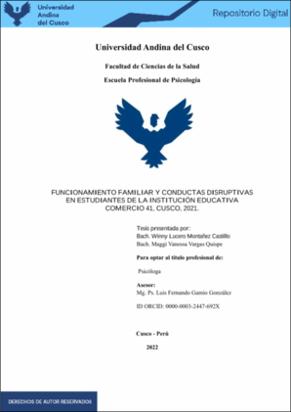| dc.contributor.advisor | Gamio González, Luis Fernando | |
| dc.contributor.author | Montañez Castillo, Winny Lucero | |
| dc.contributor.author | Vargas Quispe, Maggi Vanessa | |
| dc.date.accessioned | 2023-04-03T15:21:51Z | |
| dc.date.available | 2023-04-03T15:21:51Z | |
| dc.date.issued | 2022-12-27 | |
| dc.identifier.uri | https://hdl.handle.net/20.500.12557/5294 | |
| dc.description.abstract | El propósito que tuvo el estudio fue determinar la relación entre funcionamiento familiar
y las conductas disruptivas de los estudiantes de la institución educativa Comercio 41,
Cusco, 2021. El paradigma bajo la cual se desarrolló el estudio fue el cuantitativo, el
diseño empleado fue no experimental y alcance descriptivo, correlacional. Donde la
muestra fue de 228 alumnas de los 3 últimos grados de secundaria del Centro Educativo
Estatal Comercio 41, Cusco. El instrumento empleado fue “Escala de evaluación de la
cohesión y la adaptabilidad familiar Faces III con el que se midió la variable
funcionamiento familiar”, asimismo, para poder medir las conductas disruptivas se
empleó otro cuestionario. Llegando al resultado que existe un nivel de relación positiva
baja entre las conductas disruptivas y el funcionamiento familiar dado que la Rho de
Spearman fue 0,211 (21,1%) y p-valor de 0,001. Concluyendo la existencia de relación
entre el funcionamiento familiar y las conductas disruptivas fue positiva baja en los
estudiantes del Centro Educativo Estatal Comercio 41, Cusco, 2021. | es_PE |
| dc.description.abstract | The purpose of the study was to determine the relationship between family functioning
and the disruptive behaviors of the students of the educational institution Comercio 41,
Cusco, 2021. The paradigm under which the study was developed was quantitative, the
design used was non-experimental. and descriptive, correlational scope. Where the
sample was 228 students from the last 3 grades of secondary school of the State
Educational Center Commerce 41, Cusco. The instrument used was "Faces III family
cohesion and adaptability assessment scale with which the family functioning variable
was measured", have, in order to measure disruptive behaviors another questionnaire was
used. Reaching the result that there is a low level of positive relationship between
disruptive behaviors and family functioning given that Spearman's Rho was 0.211
(21.1%) and p-value of 0.001. Concluding the existence of a relationship between family
functioning and disruptive behaviors, it was positively low in the students of the State
Educational Center Commerce 41, Cusco, 2021. | en_US |
| dc.format | application/pdf | es_PE |
| dc.language.iso | spa | es_PE |
| dc.publisher | Universidad Andina del Cusco | es_PE |
| dc.rights | info:eu-repo/semantics/restrictedAccess | es_PE |
| dc.rights.uri | https://creativecommons.org/licenses/by-nc-nd/4.0/ | es_PE |
| dc.subject | Conductas disruptivas | es_PE |
| dc.subject | Cohesión | es_PE |
| dc.subject | Funcionamiento familiar | es_PE |
| dc.title | Funcionamiento familiar y conductas disruptivas en estudiantes de la Institución Educativa Comercio 41, Cusco, 2021 | es_PE |
| dc.type | info:eu-repo/semantics/bachelorThesis | es_PE |
| thesis.degree.name | Psicóloga | es_PE |
| thesis.degree.grantor | Universidad Andina del Cusco. Facultad de Ciencias de la Salud | es_PE |
| thesis.degree.discipline | Psicología | es_PE |
| dc.publisher.country | PE | es_PE |
| dc.subject.ocde | https://purl.org/pe-repo/ocde/ford#5.01.00 | es_PE |
| renati.advisor.dni | 43793076 | |
| renati.advisor.orcid | https://orcid.org/0000-0003-2447-692X | es_PE |
| renati.author.dni | 73906384 | |
| renati.author.dni | 70309261 | |
| renati.discipline | 313016 | es_PE |
| renati.juror | Durand Guzmán, Juan Segismundo | |
| renati.juror | Vila Nuñonca, Gildo | |
| renati.juror | Boisseranc Bonett, Maria del Carmen Virginie | |
| renati.juror | Cárdenas Chacón, Milagros | |
| renati.level | https://purl.org/pe-repo/renati/level#tituloProfesional | es_PE |
| renati.type | https://purl.org/pe-repo/renati/type#tesis | es_PE |



